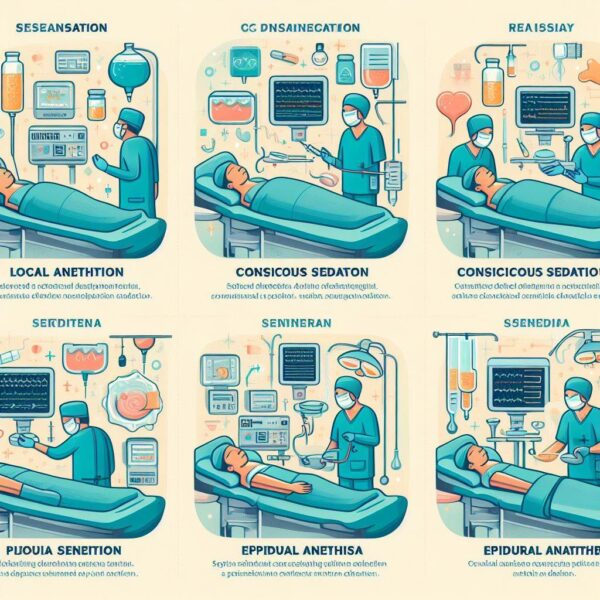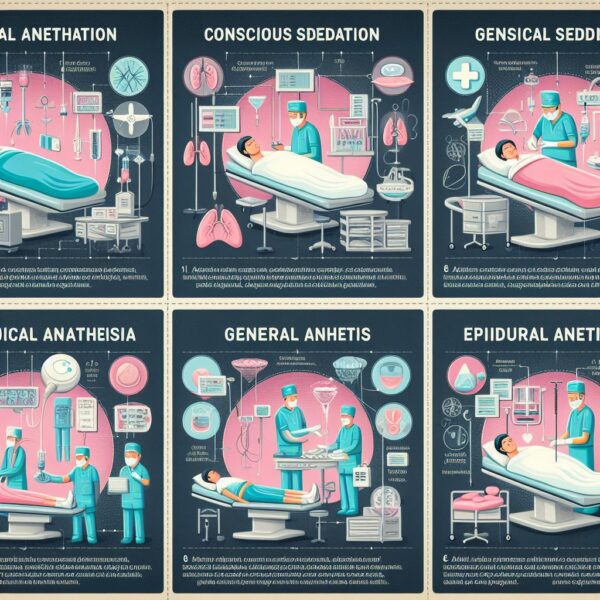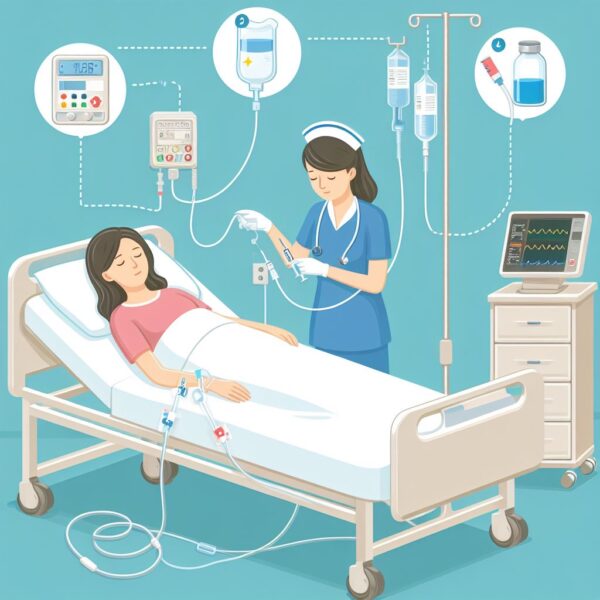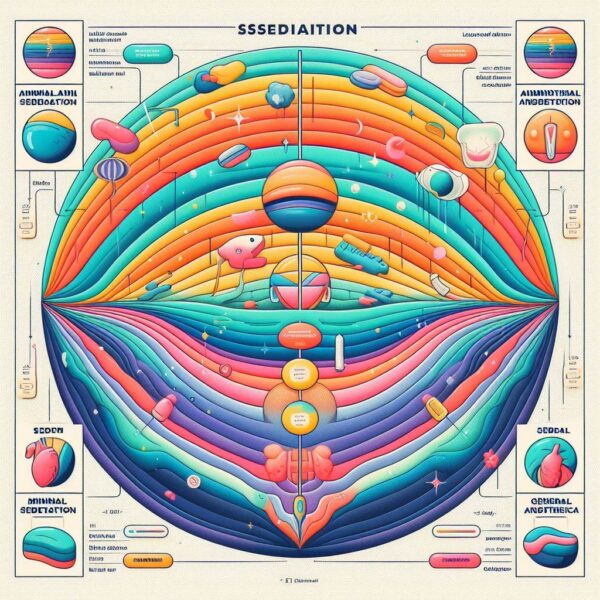
Sedation dentistry has transformed the dental experience for many patients, offering relaxation and comfort during dental procedures. There are various types of sedation available, each catering to different levels of anxiety and discomfort.
From mild sedation techniques to deeper levels of sedation, understanding the options can help patients and dentists choose the most suitable approach for individual needs. In this article, we’ll explore the different types of sedation used in dentistry, shedding light on their mechanisms, benefits, and considerations.
Whether it’s mild oral sedation, nitrous oxide, or intravenous sedation, knowing the options empowers patients to make informed decisions about their dental care and alleviate any apprehensions about visiting the dentist.
Types Of Sedation

1. Nitrous Oxide Sedation (Laughing Gas):
Nitrous oxide, administered through a mask worn over the nose, induces a relaxed state while allowing patients to remain conscious and responsive. It’s often used for mild to moderate anxiety and can be adjusted throughout the procedure.
2. Oral Sedation:
Oral sedatives, typically in the form of a pill, are taken before the dental appointment to induce relaxation. While patients remain conscious, they may feel drowsy and relaxed. This type of sedation is suitable for mild to moderate anxiety levels.
3. Intravenous (IV) Sedation:
Administered through a vein, IV sedation delivers medication directly into the bloodstream, inducing a deeper state of relaxation or even sleep. It’s often used for more complex procedures or patients with severe anxiety.
4. General Anesthesia:
General anesthesia renders patients unconscious and unaware during dental procedures. It’s typically reserved for extensive treatments or patients with extreme dental phobia.
5. Local Anesthesia:
While not a form of sedation, local anesthesia numbs the area being treated, providing pain relief during dental procedures. It’s commonly used in conjunction with sedation techniques to ensure patient comfort.
6. Combination Sedation:
Dentists may combine different types of sedation techniques to tailor the experience to individual patient needs. For example, combining nitrous oxide with oral sedation can provide both relaxation and deeper sedation effects.
7. Minimal Sedation:
Also known as conscious sedation, minimal sedation induces a relaxed state while allowing patients to remain awake and responsive. It’s often used for patients with mild anxiety or those undergoing minor procedures.
8. Moderate Sedation:
Moderate sedation, also called conscious sedation, induces a deeper state of relaxation while still allowing patients to respond to stimuli. Patients may have limited memory of the procedure and may slur their words.
9. Deep Sedation:
Deep sedation induces a state of profound relaxation bordering on unconsciousness. Patients may not be easily aroused and may require assistance with breathing.
10. Patient-Controlled Sedation:
Some sedation techniques, such as patient-controlled analgesia (PCA), allow patients to self-administer medication within preset safety limits, giving them a sense of control over their sedation level. I hope after reading this far your able to understand about Types Of Sedation.
What Is Sedation

Sedation dentistry has become increasingly popular in recent years, offering patients a way to alleviate anxiety and discomfort during dental procedures. Sedation involves the use of medications to induce a relaxed state, making dental visits more manageable for individuals who may experience fear or apprehension.
This approach has transformed the dental experience for many, allowing patients to receive necessary treatments with minimal stress. Understanding what sedation entails and its various applications is essential for both patients and dental professionals.
In this article, we’ll explore the concept of sedation in dentistry, its benefits, and how it enhances the overall dental care experience.
Understanding Sedation:
Sedation in dentistry refers to the administration of medications to help patients relax during dental procedures. It is commonly used for individuals who experience dental anxiety, fear, or phobia, as well as those undergoing lengthy or complex treatments.
There are several levels of sedation available, ranging from mild to deep, depending on the patient’s needs and the nature of the procedure. Mild forms of sedation, such as nitrous oxide (laughing gas) or oral sedatives, induce a state of relaxation while allowing the patient to remain conscious and responsive. These methods are often used for patients with mild to moderate anxiety and for less invasive procedures.
For patients with more severe anxiety or for extensive dental work, deeper levels of sedation may be recommended. This can include intravenous (IV) sedation, which delivers medication directly into the bloodstream to induce a deeper state of relaxation or sleep. General anesthesia, which renders the patient unconscious, may also be used for certain procedures.
The goal of sedation dentistry is to create a calm and comfortable environment for patients, allowing them to receive the dental care they need without experiencing undue stress or discomfort. Sedation can help patients relax, alleviate fears, and make dental visits more manageable, ultimately improving their overall oral health and well-being.
It’s important for patients to discuss their concerns and preferences with their dentist to determine the most appropriate sedation option for their specific needs. Dentists will consider factors such as the patient’s medical history, the complexity of the procedure, and their level of anxiety when recommending a sedation approach.
With the right sedation techniques in place, patients can undergo dental treatment with greater ease and confidence, leading to better oral health outcomes in the long run.
What Is Sedation Importance

The significance of sedation in dentistry cannot be overstated, as it plays a pivotal role in transforming the dental experience for countless individuals. Sedation dentistry encompasses various techniques aimed at easing anxiety, discomfort, and fear associated with dental procedures, thereby improving patient comfort and enhancing treatment outcomes.
By promoting relaxation and reducing stress, sedation enables patients to undergo necessary dental treatments with greater ease and confidence, ultimately leading to better oral health and overall well-being.
In this article, we’ll explore the importance of sedation in dentistry, highlighting its role in overcoming barriers to care, facilitating complex treatments, and improving patient satisfaction.
Understanding the value of sedation empowers patients to make informed decisions about their dental care and fosters a positive and supportive environment within the dental office.
Importance Of Sedation:
1. Overcoming Dental Anxiety:
Sedation helps alleviate dental anxiety and fear, which are common deterrents to seeking dental care. By inducing a state of relaxation, sedation enables patients to feel more comfortable and at ease during dental procedures, encouraging them to seek treatment without hesitation.
2. Enhancing Patient Comfort:
Sedation promotes patient comfort by reducing stress, discomfort, and pain associated with dental treatments. Patients can undergo procedures with minimal discomfort, leading to a more positive and pleasant experience overall.
3. Facilitating Complex Treatments:
Sedation allows for the completion of lengthy or complex dental treatments in a single visit, minimizing the need for multiple appointments and reducing inconvenience for patients. This is particularly beneficial for individuals with busy schedules or those undergoing extensive dental work.
4. Improving Treatment Efficiency:
By helping patients remain calm and cooperative during treatment, sedation enhances treatment efficiency and effectiveness. Dentists can perform procedures with greater precision and accuracy, leading to better outcomes and patient satisfaction.
5. Promoting Patient Cooperation:
Sedation facilitates cooperation and compliance among patients, particularly children or individuals with special needs who may have difficulty sitting still or tolerating dental procedures. Patients are more likely to cooperate and follow instructions when they are relaxed and comfortable.
6. Reducing Dental Phobia:
For individuals with severe dental phobia or anxiety, sedation dentistry offers a lifeline, enabling them to receive necessary dental care without experiencing overwhelming fear or distress. Sedation helps patients feel more at ease and in control during their dental visits.
7. Creating a Positive Environment:
Incorporating sedation techniques into dental practice fosters a positive and supportive environment for patients. Dentists can build trust and rapport with their patients by addressing their concerns and ensuring a comfortable and stress-free experience.
What Is Type 4 Sedation?

Type 4 sedation represents a significant approach in sedation dentistry, providing patients with a profound level of relaxation and comfort during dental procedures. Commonly referred to as general anesthesia, type 4 sedation induces a state of unconsciousness, ensuring patients are unaware and unresponsive throughout their treatment.
This form of sedation is typically reserved for complex dental procedures or individuals with severe anxiety or special needs. Understanding the intricacies of type 4 sedation is crucial for both dental professionals and patients, as it offers a solution for those requiring extensive or challenging treatments.
In this article, we’ll delve into the concept of type 4 sedation, its applications, benefits, and considerations, shedding light on how it enhances the dental care experience for individuals in need of comprehensive or intricate procedures.
Understanding Type 4 Sedation:
Type 4 sedation, also known as general anesthesia, is a highly effective method used in dentistry to achieve a state of unconsciousness in patients undergoing dental procedures. Unlike other forms of sedation that maintain varying levels of consciousness, type 4 sedation renders patients completely unconscious and unresponsive throughout the duration of the treatment.
This deep level of sedation is typically administered by a qualified anesthesia provider, such as an anesthesiologist or nurse anesthetist, who carefully monitors the patient’s vital signs and adjusts the level of sedation as needed to ensure their safety and comfort.
Type 4 sedation is particularly beneficial for complex dental procedures that require extensive time or involve significant discomforts, such as oral surgeries, implant placements, or full-mouth reconstructions. By inducing unconsciousness, type 4 sedation allows patients to undergo these treatments without experiencing pain, anxiety, or awareness of their surroundings.
Individuals with severe dental phobia or anxiety may also benefit from type 4 sedation, as it offers a solution for those who may otherwise avoid seeking dental care due to fear or distress. By providing a deep level of relaxation, type 4 sedation enables these patients to receive the necessary treatment without experiencing psychological discomfort.
Before administering type 4 sedation, patients undergo a thorough evaluation to assess their medical history, current health status, and any risk factors that may affect sedation outcomes. An individualized sedation plan is then developed to meet the specific needs and requirements of each patient, ensuring their safety and well-being throughout the procedure.
What Are The Classification Of Sedation?

Understanding the classification of sedation in dentistry is essential for both dental professionals and patients, as it helps determine the appropriate sedation technique for specific procedures and individual needs. Sedation can range from mild to deep levels, each serving different purposes and providing varying degrees of relaxation and consciousness.
By familiarizing themselves with the classification system, dental professionals can ensure safe and effective sedation practices, while patients can make informed decisions about their dental care.
In this article, we’ll explore the different classifications of sedation in dentistry, highlighting their characteristics, applications, and considerations.
Whether it’s minimal sedation for routine cleanings or deep sedation for complex surgeries, understanding the classification system empowers both patients and dental professionals to navigate sedation dentistry with confidence and clarity.
Exploring The Classification Of Sedation:
1. Minimal Sedation (Anxiolysis):
Minimal sedation induces a relaxed state while allowing patients to remain fully conscious and responsive. It is commonly used for patients with mild anxiety or discomfort during routine dental procedures, such as cleanings or fillings.
2. Moderate Sedation (Conscious Sedation):
Moderate sedation produces a deeper level of relaxation, where patients may feel drowsy and may have limited memory of the procedure. However, they can still respond to verbal commands and stimuli. Moderate sedation is often used for more extensive dental treatments, such as root canals or extractions.
3. Deep Sedation:
Deep sedation induces a state of profound relaxation bordering on unconsciousness. Patients may be only partially responsive or may not be easily aroused. Deep sedation is typically reserved for complex procedures or patients with severe anxiety or special needs.
4. General Anesthesia (Type 4 Sedation):
General anesthesia results in complete unconsciousness, where patients are unresponsive to stimuli and have no memory of the procedure. It is used for extensive surgeries or procedures where the patient needs to be completely unaware and immobile, such as complex oral surgeries or full-mouth reconstructions.
5. Nitrous Oxide Sedation (Inhalation Sedation):
Nitrous oxide, also known as laughing gas, is a form of sedation administered through inhalation. It induces a mild level of relaxation and euphoria while allowing patients to remain conscious and responsive. Nitrous oxide sedation is commonly used for patients with mild anxiety or children undergoing dental procedures.
6. Oral Sedation:
Oral sedation involves the administration of sedative medications in pill form to induce relaxation and reduce anxiety. Patients may feel drowsy or groggy but can still respond to stimuli. Oral sedation is often used for patients with moderate anxiety or those undergoing more invasive procedures.
7. Intravenous (IV) Sedation:
Intravenous sedation delivers sedative medications directly into the bloodstream, resulting in a rapid onset of relaxation and sedation. It can be adjusted throughout the procedure to maintain the desired level of sedation. IV sedation is commonly used for moderate to deep sedation in patients undergoing oral surgeries or extensive dental treatments.
What Is The Most Commonly Used Sedation?

Exploring the realm of sedation dentistry unveils a variety of techniques aimed at providing patients with a comfortable and stress-free dental experience. Among the array of sedation options available, certain methods stand out as the most commonly utilized by dental professionals.
Understanding the prevalence and characteristics of these sedation techniques is essential for both patients and dental practitioners, as it influences treatment planning and patient care.
In this article, we delve into the most commonly used sedation method in dentistry, shedding light on its mechanisms, benefits, and applications.
By gaining insight into the primary sedation approach employed by dental professionals, patients can make informed decisions about their dental care and approach dental appointments with confidence and ease.
Most Commonly Used Sedation Method:
1. Nitrous Oxide Sedation (Laughing Gas):
Nitrous oxide sedation is one of the most commonly used sedation techniques in dentistry. It involves administering a mixture of nitrous oxide and oxygen through a mask worn over the nose. This method induces a mild level of sedation and relaxation while allowing patients to remain conscious and responsive throughout the procedure.
2. Oral Sedation:
Oral sedation, administered in the form of a pill or liquid medication, is another widely utilized sedation method. Patients take the prescribed sedative medication before their dental appointment, resulting in a relaxed and drowsy state during the procedure. Oral sedation is particularly beneficial for patients with mild to moderate anxiety or those undergoing longer or more invasive treatments.
3. Intravenous (IV) Sedation:
Intravenous sedation involves delivering sedative medications directly into the bloodstream through a vein, resulting in rapid onset and precise control of sedation levels. This method is commonly used for patients undergoing extensive dental procedures or those with moderate to severe anxiety.
4. Minimal Sedation (Anxiolysis):
Minimal sedation, also known as anxiolysis, is achieved using techniques such as nitrous oxide or oral sedatives to induce a relaxed state while allowing patients to remain fully conscious and responsive. This approach is often employed for routine dental procedures or for patients with mild anxiety.
5. Moderate Sedation (Conscious Sedation):
Moderate sedation produces a deeper level of relaxation than minimal sedation, where patients may feel drowsy and have limited memory of the procedure. While still conscious, patients are less responsive to stimuli and may require assistance with activities such as walking or speaking.
6. General Anesthesia:
While less common in routine dental practice, general anesthesia is sometimes used for complex or invasive dental procedures. It induces a state of unconsciousness, rendering patients completely unaware and unresponsive during the procedure. General anesthesia is typically administered by an anesthesia provider and requires careful monitoring of the patient’s vital signs.
Conclusion:
In the realm of dentistry, the availability of various sedation techniques has revolutionized the patient experience, offering comfort and relaxation during dental procedures. Understanding the different types of sedation empowers patients to make informed decisions about their dental care, while dental professionals can tailor sedation methods to meet individual needs.
Whether it’s mild sedation for routine cleanings or deep sedation for complex surgeries, the diversity of sedation options ensures that patients can receive the care they need with minimal discomfort or anxiety.
By recognizing the importance of sedation in dentistry and embracing the range of techniques available, both patients and dental professionals contribute to a positive and stress-free dental experience. I hope now you fully understand everything about Types Of Sedation.
FAQs:
Q1: What are the different types of sedation used in dentistry?
A: The different types of sedation used in dentistry include minimal sedation (anxiolysis), moderate sedation (conscious sedation), deep sedation, general anesthesia, nitrous oxide sedation, oral sedation, and intravenous (IV) sedation.
Q2: Is sedation dentistry safe?
A: Yes, sedation dentistry is safe when administered by trained and qualified dental professionals. Before undergoing sedation, patients undergo a thorough evaluation to assess their medical history and suitability for sedation.
Q3: Which type of sedation is best for me?
A: The best type of sedation depends on various factors, including the patient’s medical history, anxiety level, and the nature of the dental procedure. Dental professionals will assess these factors to determine the most suitable sedation method for each patient.
Q4: How long does sedation last?
A: The duration of sedation varies depending on the type of sedation used and the individual patient’s response. Minimal sedation may wear off quickly after the procedure, while deeper levels of sedation may require more time for recovery.
Q5: Are there any side effects of sedation?
A: While sedation is generally safe, some patients may experience temporary side effects such as drowsiness, dizziness, or nausea. Serious complications are rare but may occur in certain cases, which is why careful monitoring during sedation is essential.
